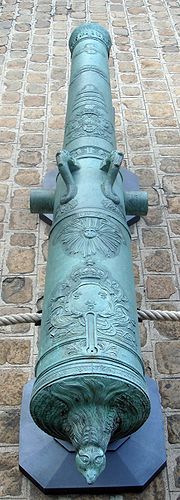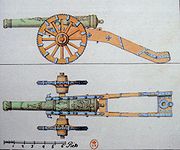
Florent-Jean de Vallière
Encyclopedia
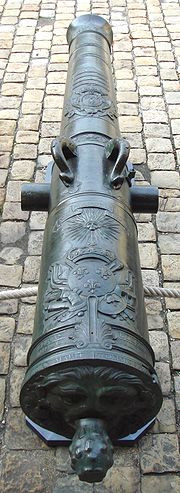
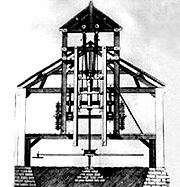
Through the Royal Ordonnance of October 7, 1732, de Vallière endeavoured to reorganize and standardize the King's artillery. He significantly improved the method used for founding cannons, superseding the technique developed by Jean-Jacques Keller
Jean-Jacques Keller
Jean-Jacques Keller and his brother Jean-Balthazar Keller were Swiss gunfounders from Zürich, in the service of France....
. He thus developed the de Vallière system, which set the standard for French artillery until the advent of the Gribeauval system.
De Vallière system
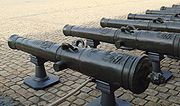
Canon de 24 de Vallière
The Canon de 24 de Vallière was a type of cannon designed by the French officer Florent-Jean de Vallière , Director-General of the Battalions and Schools of the Artillery....
), 12, 8 and 4 pound guns, mortars of 12 and 8 French inches, and stone-throwing mortars of 15 French inches.
The French pound weighting 1.097 English pounds, the French guns fired slightly heavier balls (13.164 pounds) than their English equivalent 12-pounder. The French inch was 2.707 cm, slightly longer than the English inch of 2.52 cm.
The de Vallière system used core drilling of the bore of cannons founded in one piece of bronze
Bronze
Bronze is a metal alloy consisting primarily of copper, usually with tin as the main additive. It is hard and brittle, and it was particularly significant in antiquity, so much so that the Bronze Age was named after the metal...
, a method developed at that time by Jean Maritz
Jean Maritz
Jean Maritz , also Johan Maritz, was a Swiss inventor, born in Burgdorf, Canton of Bern, who moved to France, becoming "Commissaire des Fontes" at Strasbourg , and invented the vertical drilling machine, as well as the horizontal drilling machine for cannons in the 18th century...
, which allowed for much higher precision of the bore shape and surface, and therefore higher shooting efficiency.
The de Valliere guns were also highly decorative and contained numerous designs and inscriptions.
Muzzle

Louis-Charles, Count of Eu
Louis Charles de Bourbon, Count of Eu was a grandson of Louis XIV of France and his Maîtresse-en-titre Françoise-Athénaïs de Montespan. He was a member of the legitimised house of Bourbon du Maine...
", the Grand Maître de l'artillerie de France (Grand Master of the Artillery of France), followed by a royal emblem. In the middle of the cannon were trunnions used to position the gun in place and elevate or depress it. On top of the trunnion
Trunnion
A trunnion is a cylindrical protrusion used as a mounting and/or pivoting point. In a cannon, the trunnions are two projections cast just forward of the centre of mass of the cannon and fixed to a two-wheeled movable gun carriage...
s were dolphin-shaped ornaments used in lifting the gun.
Barrel
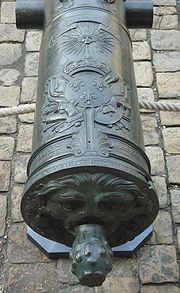
Nec pluribus impar
Nec pluribus impar is a Latin motto adopted by Louis XIV of France from 1658. It was often inscribed together with the symbol of the "Sun King": a head within rays of sunlight.-Meaning:...
," meaning that the King is "No unequal match for many," i.e. "None his equal." This was followed by the royal crest of the Bourbon dynasty. The location and date of manufacture were inscribed (in the example "Strasbourg, 1745") at the bottom of the gun, and finally the name and title of the founder (in the example "Fondu par Jean Maritz
Jean Maritz
Jean Maritz , also Johan Maritz, was a Swiss inventor, born in Burgdorf, Canton of Bern, who moved to France, becoming "Commissaire des Fontes" at Strasbourg , and invented the vertical drilling machine, as well as the horizontal drilling machine for cannons in the 18th century...
, Commissaire des Fontes"). The breech was decorated with an animal face showing the rating of the gun (in the example the lion head for a 24-pounder).
Breech design
The guns had cascabelCascabel (artillery)
A cascabel is a subassembly of a muzzle loading cannon - a place to attach arresting ropes to deal with the recoil of firing the cannon.Generally comprising the knob and the neck , with particular models also featuring a filet . By some definitions, the cascabel additionally includes the base of...
designs which allowed to easily recognize their rating: a 4-pounder would have a "Face in a sunburst", an 8-pounder a "Monkey head", a 12-pounder a "Rooster head", a 16-pounder a "Medusa head", and a 24-pounder a "Bacchus head" or a "Lion head".
Operational activity
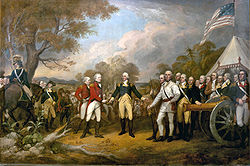
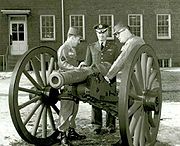
War of the Austrian Succession
The War of the Austrian Succession – including King George's War in North America, the Anglo-Spanish War of Jenkins' Ear, and two of the three Silesian wars – involved most of the powers of Europe over the question of Maria Theresa's succession to the realms of the House of Habsburg.The...
(1747-1748), and during the Seven Years War (1756-1763) were mobility was a key factor and lighter guns were clearly in need. The lack of howitzer
Howitzer
A howitzer is a type of artillery piece characterized by a relatively short barrel and the use of comparatively small propellant charges to propel projectiles at relatively high trajectories, with a steep angle of descent...
was another issue.
Numerous de valliere guns were used in the American War of Independence, especially the smaller 4-pdr field guns. The guns were shipped from France
France
The French Republic , The French Republic , The French Republic , (commonly known as France , is a unitary semi-presidential republic in Western Europe with several overseas territories and islands located on other continents and in the Indian, Pacific, and Atlantic oceans. Metropolitan France...
, and the field carriages provided for in the US. These guns played an important role in such battles as the Battle of Saratoga, and the Siege of Yorktown
Siege of Yorktown
The Siege of Yorktown, Battle of Yorktown, or Surrender of Yorktown in 1781 was a decisive victory by a combined assault of American forces led by General George Washington and French forces led by the Comte de Rochambeau over a British Army commanded by Lieutenant General Lord Cornwallis...
. George Washington
George Washington
George Washington was the dominant military and political leader of the new United States of America from 1775 to 1799. He led the American victory over Great Britain in the American Revolutionary War as commander-in-chief of the Continental Army from 1775 to 1783, and presided over the writing of...
wrote about the guns in a letter to General Heath
Heath
-Habitats:* Heath or heathland, low-growing woody vegetation, mostly consisting of heathers and related species* Heaths in the British National Vegetation Classification system...
on 2 May, 1777:
Obsolescence
